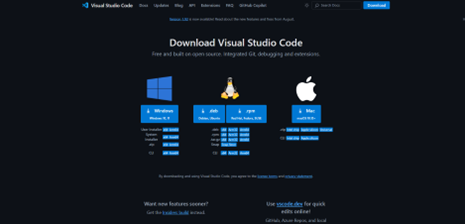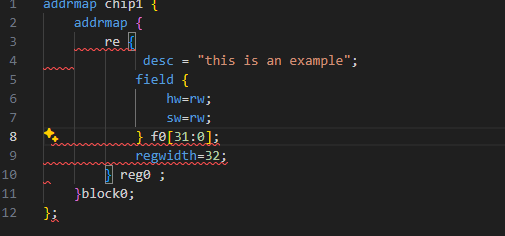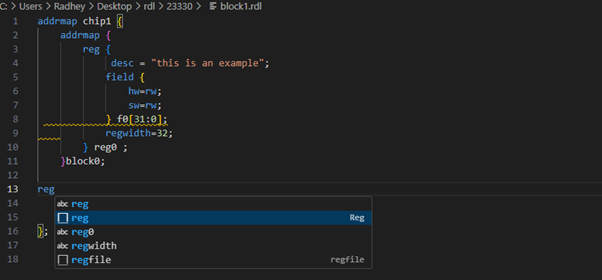The Agnisys SystemRDL Extension in VS Code: Revolutionizing Register Design Validation and Development
The Agnisys SystemRDL Extension in Visual Studio Code (VS Code) is a powerful tool for hardware designers working with SystemRDL—the industry-standard language for describing and configuring registers and addressable blocks in hardware. With this extension, developers can streamline their development process by receiving real-time feedback, code validation, and context-based hints that enhance productivity and reduce errors.
In this article, we’ll explore the key features of the SystemRDL Extension for VS Code and how it helps developers with validation, hinting, error reporting, and faster development.
What is SystemRDL?
Before we dive into The Agnisys SystemRDL Extension, it’s important to understand SystemRDL. System Register Description Language (SystemRDL) is used to describe registers in a concise, readable, and tool-interoperable way. It defines various register fields and access policies, and can be used to generate both documentation and register access code automatically.
SystemRDL is essential in hardware design as it ensures consistency in register design across different IP blocks and system on chip (SoC) designs, preventing bugs, enhancing readability, and improving productivity.
The Need for a SystemRDL Extension in VS Code
While SystemRDL is powerful, managing complex register definitions manually can become cumbersome. Designers need a way to validate their code as they write it, receive suggestions, catch errors early, and avoid costly mistakes later in the design cycle.
VS Code, known for its lightweight, extensible nature, has become a popular IDE for a range of programming and hardware description languages. A SystemRDL extension for VS Code provides:
- Real-time Validation: Get instant feedback on syntax and logical errors in your SystemRDL code.
- Code Hinting: Receive intelligent suggestions and auto-completions that make writing complex register structures easier.
- Error Highlighting: Easily identify syntax and semantic issues with highlighted errors and warnings, reducing debugging time.
- Faster Development: Leverage VS Code’s productivity features, like IntelliSense, to speed up register design.
Key Features of Agnisys SystemRDL Extension for VS Code
- Real-Time Validation:
- One of the most valuable features of the SystemRDL extension is on-the-fly validation. As you type, the extension checks your code for syntax errors, type mismatches, or incorrect configurations.
- Any mistakes, such as a missing semicolon or an invalid access policy, are flagged in real time, allowing you to correct them instantly. This prevents compilation errors that would otherwise occur at a later stage.
- For instance, when defining a register field with incorrect or missing attributes, the extension will immediately notify you and suggest corrections.
- Syntax Highlighting:
- SystemRDL syntax can be complex due to its hierarchical nature. The extension provides rich syntax highlighting, making your code more readable. Different colors are assigned to different SystemRDL constructs (registers, fields, etc.), making it easier to identify structures at a glance.
- Code Hinting and Auto-Completion:
- The IntelliSense feature in VS Code is integrated into the SystemRDL extension, providing auto-completion and code suggestions based on your context.
- When defining a register or field, the extension suggests possible keywords, properties (such as field, regwidth, or reset), and values based on SystemRDL syntax. This speeds up your coding and helps avoid errors due to typos or missing keywords.
- If you forget certain SystemRDL constructs, such as what parameters are required for a register, the extension helps by showing possible values or hints in the form of tooltips.
- Error Highlighting:
- Errors in SystemRDL design can range from missing mandatory fields to incorrect usage of parameters. The extension identifies these issues and highlights them directly in the editor.
- For example, if a register is missing an address, or an enum value is incorrectly defined, the error will be highlighted, and the Problems tab in VS Code will show a detailed description of the issue.
- Linting:
- Linting is a useful feature that analyzes code for stylistic issues and potential errors that don’t prevent compilation but may cause problems later. The SystemRDL extension includes built-in linting rules to ensure that your code adheres to best practices.
- Linting helps in maintaining a clean, consistent codebase, especially when working in teams or across multiple IP blocks.
- Integration with SystemRDL Simulators and Tools:
- The SystemRDL extension can integrate with SystemRDL tools, including simulators and code generators, allowing you to validate your SystemRDL code and generate RTL (Register Transfer Level) code or documentation directly from the editor.
- This makes the extension not just a development tool but also a part of the overall verification and design flow, ensuring that your code is both correct and implementable.
- Faster Development with Code Snippets:
- Predefined code snippets are available to help you quickly insert commonly used structures, such as register definitions, field attributes, and more. Instead of writing out repetitive code, you can invoke these snippets to instantly generate blocks of code, reducing manual work.
- For example, typing reg might trigger a template for a register definition, allowing you to fill in the specifics rather than writing the entire block from scratch.
Benefits of Using SystemRDL Extension in VS Code
- Improved Productivity:
- The extension reduces the time required to write and debug SystemRDL code by providing real-time validation, syntax checking, and intelligent code suggestions. You spend less time fixing errors and more time designing.
- Error-Free Development:
- Catching mistakes early, whether syntax or logical, means fewer bugs make it into your final design. This ensures a more reliable and robust register description, saving time in the verification and testing stages.
- Collaboration and Consistency:
- Using VS Code, a widely-used editor, ensures that teams can standardize on the same development environment. With features such as linting, code styles remain consistent, making it easier for teams to collaborate on large projects.
- Seamless Integration with Existing Workflows:
- The extension works seamlessly within the VS Code ecosystem, allowing developers to use familiar tools like Git, task runners, and debugging consoles, all while designing registers.
Getting Started
To start using the SystemRDL Extension in VS Code:
- Install Visual Studio Code, If it is not already installed.
 Download the latest version of VS Code based on your operating system.
Download the latest version of VS Code based on your operating system. - Click on the highlighted button to search for the extension.

- In the search bar, type ‘Agnisys SystemRDL’ and then click ‘Install’ on the first option to add the extension.
 Ensure you have Java 8 or above. You can download it from Oracle’s website.
Ensure you have Java 8 or above. You can download it from Oracle’s website. - Open your SystemRDL files and enjoy real-time validation, auto-completion, and error reporting as you write.

- You can begin writing SystemRDL code in the file, and the Agnisys SystemRDL VS Code Extension will assist you with code hinting, linting, and auto-suggestions.
With this extension, your SystemRDL development will be faster, more accurate, and more enjoyable!
Conclusion
The SystemRDL Extension for VS Code is a game-changer for hardware developers working on register designs. By providing real-time validation, error highlighting, code hinting, and faster development cycles, it significantly enhances your productivity and reduces the risk of errors. Whether you’re designing a small IP block or a large SoC, this extension ensures that your register definitions are accurate, consistent, and easy to maintain.
With the increasing complexity of hardware designs, tools like the SystemRDL extension are essential for staying ahead of the curve and ensuring that register design is efficient, error-free, and scalable.









